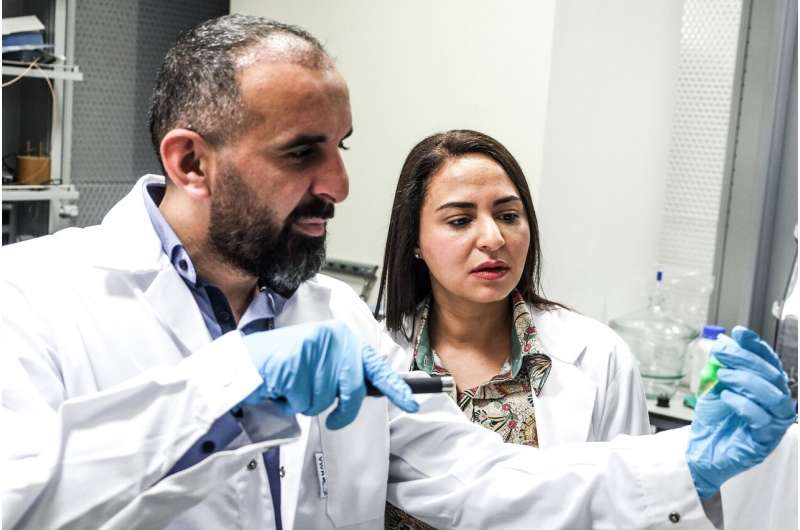Researchers synthesize gold nanoparticles capable of attacking cancer cells

A team of NYU Abu Dhabi (NYUAD) researchers have developed a new, one-pot synthetic approach to obtain water-stable and "ready to use" gold nanoparticles that can be heated with a simple green laser, improving the gold nanoparticles' ability to penetrate and destroy malignant cells through hyperthermia and simultaneously releasing chemotherapeutic drugs. The unique design of these nanoparticles reduces the side effects of the drugs, potentially improving patients' quality of life.
In the paper titled "Aqueous Synthesis of Triphenylphosphine-Modified Gold Nanoparticles for Synergistic In Vitro and In Vivo Photo-thermal Chemotherapy," published in Chemistry—A European Journal, NYUAD Research Scientist Farah Benyettou and Associate Professor of Chemistry Ali Trabolsi, in collaboration with Professor of Biology Kirsten Sadler, presented the process of creating triphenylphosphine-functionalized gold nanoparticles by simply heating a solution of the triphenylphosphine gold (I) chloride salt in water under microwave irradiations. Biocompatible gold nanoparticles coated on the surface with triphenylphosphine molecules penetrate cancerous cells in preference. By combining the nanoparticles with heat, the researchers found dramatically improved cell killing compared with heat or the nanoparticles alone. Combined therapies, and consequently improved cancerous cell killing, were achieved when cancer cells were irradiated with a green laser.
Since nanoparticles are constrained to the area of the cancerous tissue, the heat produced by absorbed laser energy causes the localized temperature to rise and release the drug that kills the cancer cells without damaging the surroundings. Therefore, nanoparticles are actually heating agents and drug delivery systems. The drug-coated particles manifested strong potential to act as an antimetastatic agent by inhibiting adhesion and invasion of cancer cells.
Trabolsi commented, "In addition to being environmentally-conscious and economical, this new approach presents a range of possibilities for the further development of novel phosphine-functionalized nanoparticles."
"These 'ready-to-use' water-soluble nanoparticles possess a programmable anti-cancer drug-releasing ability and pH/photo-thermal dual responsiveness that allow them to leave healthy cells unharmed," said Benyettou.
More information: Farah Benyettou et al. Aqueous Synthesis of Triphenylphosphine‐Modified Gold Nanoparticles for Synergistic In Vitro and In Vivo Photo‐thermal Chemotherapy, Chemistry – A European Journal (2020). DOI: 10.1002/chem.202000216
Journal information: Chemistry – A European Journal
Provided by New York University



















